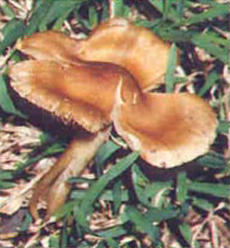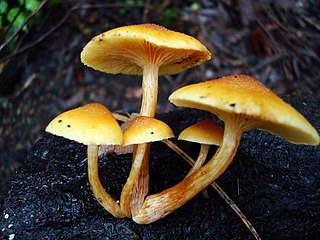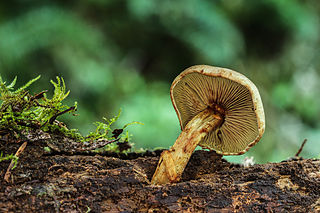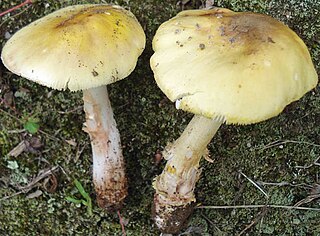
Psilocybe azurescens is a species of psychedelic mushroom whose main active compounds are psilocybin and psilocin. It is among the most potent of the tryptamine-bearing mushrooms, containing up to 1.8% psilocybin, 0.5% psilocin, and 0.4% baeocystin by dry weight, averaging to about 1.1% psilocybin and 0.15% psilocin. It belongs to the family Hymenogastraceae in the order Agaricales.

Panaeolus cinctulus, syn. Panaeolus subbalteatus, commonly known as the banded mottlegill, weed Panaeolus, belted panaeolus, or subbs is a very common, widely distributed psilocybin mushroom. According to American naturalist and mycologist David Arora, Panaeolus cinctulus is the most common psilocybin mushroom in California.

Panaeolus tropicalis is a species of psilocybin producing mushroom in the family Bolbitiaceae. It is also known as Copelandia tropicalis.

Inocybe aeruginascens is a member of the genus Inocybe which is widely distributed in Europe. The species was first documented by I. Ferencz in Ócsa, Hungary on June 15, 1965.

Gymnopilus luteofolius, known as the yellow-gilled gymnopilus, is a large and widely distributed mushroom that grows in dense clusters on dead hardwoods and conifers. It grows in late July to November in the east and in the winter on the west coast of North America. It has a rusty orange spore print and a bitter taste.

Panaeolus cyanescens, commonly known as the blue staining panaeolus, is a mushroom in the Bolbitiaceae family. Panaeolus cyanescens is a common psychoactive mushroom and is similar to Panaeolus tropicalis.

Psilocybe caerulipes, commonly known as blue-foot, is a rare psilocybin mushroom of the family Hymenogastraceae, having psilocybin and psilocin as main active compounds. An older synonym is Agaricus caerulipes.

Gymnopilus aeruginosus, also known as the magic blue gym, is a mushroom-forming fungus that grows in clusters on dead wood and wood chip mulch. It is widely distributed and common in the Pacific Northwest. It has a rusty orange spore print and a bitter taste and contains the psychedelic chemical psilocybin. It was given its current name by mycologist Rolf Singer in 1951.

Gymnopilus sapineus, commonly known as the scaly rustgill or common and boring gymnopilus, is a small and widely distributed mushroom which grows in dense clusters on dead conifer wood. It has a rusty orange spore print and a bitter taste. This species does not stain blue and lacks the hallucinogen psilocybin.

Gymnopilus liquiritiae is a mushroom in the family Hymenogastraceae. The mushroom is widely distributed and grows in dense clusters on dead conifer wood. It has a rusty orange spore print, a bitter taste, and does not contain the hallucinogen psilocybin. One of its key distinguishing features is the lack of partial veil.

Psilocybe caerulescens, also known as landslide mushroom, is a psilocybin mushroom having psilocybin and psilocin as main active compounds. Along with Psilocybe mexicana and Psilocybe aztecorum, it is one of the mushrooms likely to have been used by the Aztecs and is currently used by Mazatec shamans for its entheogenic properties.

Psilocybe stuntzii, also known as Stuntz's blue legs and blue ringers it is a psilocybin mushroom of the family Hymenogastraceae, having psilocybin and psilocin as main active compounds.
Gymnopilus luteus, known as the yellow gymnopilus, is a widely distributed mushroom-forming fungus of the Eastern United States. It contains the hallucinogens psilocybin and psilocin. It is often mistaken for G. speciosissimus and G. subspectabilis.

Gymnopilus validipes is a mushroom in the family Hymenogastraceae. It is widely distributed in North America and Europe.

Psilocybe weraroa, formerly Weraroa novae-zelandiae, is a secotioid fungus in the family Hymenogastraceae. It is endemic to New Zealand, where it grows in native forests from rotting wood and woody debris. Despite its pouch-like form this species is closely related to Psilocybe cyanescens and Psilocybe subaeruginosa. As a bluing member of the genus Psilocybe it contains the psychoactive compounds psilocin and psilocybin.

Gymnopilus luteoviridis is a widely distributed mushroom-forming fungus of the Eastern United States that contains the hallucinogens psilocybin and psilocin.
Gymnopilus cyanopalmicola is a species of mushroom-forming fungus in the family Hymenogastraceae. Found in tropical Mexico, it was described as new to science by Mexican mycologist Laura Guzmán Dávalos in 2006. The flesh of this mushroom turns blue when bruised, hence the specific epithet.

Gymnopilus punctifolius is a species of mushroom in the family Hymenogastraceae found in North America.

Cortinarius infractus, commonly known as the sooty-olive Cortinarius or the bitter webcap, is an inedible basidiomycete mushroom of the genus Cortinarius. The fungus produces sooty-olive fruit bodies with sticky caps measuring up to 13 cm (5.1 in) in diameter. The fruit bodies contains alkaloids that inhibit the enzyme acetylcholinesterase.

Amanita flavorubens, also known as the yellow American blusher or the yellow American blushing amanita, is a species of the mushroom genus Amanita.


















